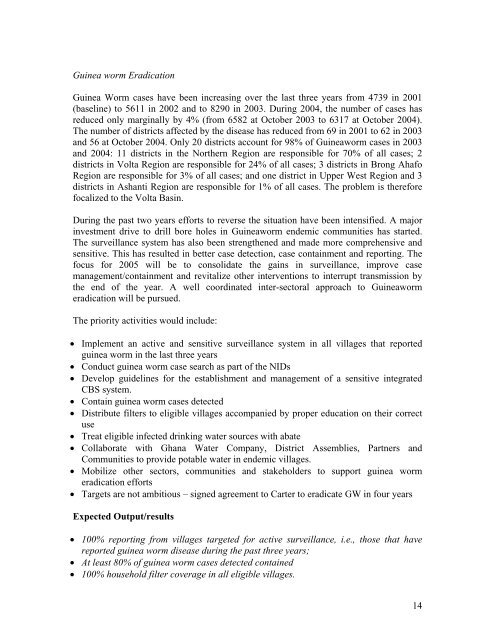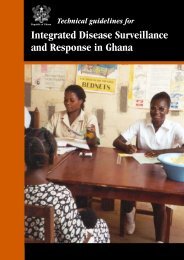Annual Programme of Work 2005 - Ministry of Health
Annual Programme of Work 2005 - Ministry of Health
Annual Programme of Work 2005 - Ministry of Health
You also want an ePaper? Increase the reach of your titles
YUMPU automatically turns print PDFs into web optimized ePapers that Google loves.
Guinea worm Eradication<br />
Guinea Worm cases have been increasing over the last three years from 4739 in 2001<br />
(baseline) to 5611 in 2002 and to 8290 in 2003. During 2004, the number <strong>of</strong> cases has<br />
reduced only marginally by 4% (from 6582 at October 2003 to 6317 at October 2004).<br />
The number <strong>of</strong> districts affected by the disease has reduced from 69 in 2001 to 62 in 2003<br />
and 56 at October 2004. Only 20 districts account for 98% <strong>of</strong> Guineaworm cases in 2003<br />
and 2004: 11 districts in the Northern Region are responsible for 70% <strong>of</strong> all cases; 2<br />
districts in Volta Region are responsible for 24% <strong>of</strong> all cases; 3 districts in Brong Ahafo<br />
Region are responsible for 3% <strong>of</strong> all cases; and one district in Upper West Region and 3<br />
districts in Ashanti Region are responsible for 1% <strong>of</strong> all cases. The problem is therefore<br />
focalized to the Volta Basin.<br />
During the past two years efforts to reverse the situation have been intensified. A major<br />
investment drive to drill bore holes in Guineaworm endemic communities has started.<br />
The surveillance system has also been strengthened and made more comprehensive and<br />
sensitive. This has resulted in better case detection, case containment and reporting. The<br />
focus for <strong>2005</strong> will be to consolidate the gains in surveillance, improve case<br />
management/containment and revitalize other interventions to interrupt transmission by<br />
the end <strong>of</strong> the year. A well coordinated inter-sectoral approach to Guineaworm<br />
eradication will be pursued.<br />
The priority activities would include:<br />
• Implement an active and sensitive surveillance system in all villages that reported<br />
guinea worm in the last three years<br />
• Conduct guinea worm case search as part <strong>of</strong> the NIDs<br />
• Develop guidelines for the establishment and management <strong>of</strong> a sensitive integrated<br />
CBS system.<br />
• Contain guinea worm cases detected<br />
• Distribute filters to eligible villages accompanied by proper education on their correct<br />
use<br />
• Treat eligible infected drinking water sources with abate<br />
• Collaborate with Ghana Water Company, District Assemblies, Partners and<br />
Communities to provide potable water in endemic villages.<br />
• Mobilize other sectors, communities and stakeholders to support guinea worm<br />
eradication efforts<br />
• Targets are not ambitious – signed agreement to Carter to eradicate GW in four years<br />
Expected Output/results<br />
• 100% reporting from villages targeted for active surveillance, i.e., those that have<br />
reported guinea worm disease during the past three years;<br />
• At least 80% <strong>of</strong> guinea worm cases detected contained<br />
• 100% household filter coverage in all eligible villages.<br />
14















